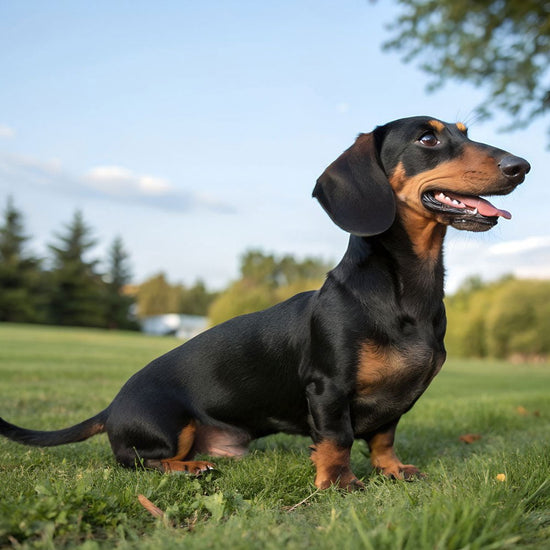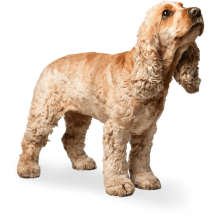

Your basket is currently empty.

Free UK Delivery. Exclusions apply.
Don't miss out! Add these must haves now.
Are you in the right place?
Please select your location so we can direct you to the right store...

Dachshund
Dachshunds may be small, although nobody told them that. These delightful dogs are lively, playful and intelligent and capture their owner's hearts with their comical and endearing ways. They can be a little headstrong occasionally, but they make truly wonderful companions you’ll quickly grow to cherish.

If you’re planning to share your life with a Dachshund, it’s only natural to wonder what lies ahead. To make things easier, we’ve put together this practical guide covering common Dachshund health problems and early warning signs to look out for.
Fondly nicknamed the “hot dog” or “sausage dog,” Dachshunds (Daxies for short) have long bodies, sturdy legs, lively personalities and an ever-alert nature.
The name Dachshund comes from the German words for badger (dachs) and dog (hund), as they were initially bred in 18th-century Germany to hunt badgers. Their hunting heritage is a testament to the Dachshund temperament and bold, determined nature, as badgers are fierce opponents.
Dachshunds come in various colours, coat types, and standard and miniature sizes.
The life expectancy for standard Dachshund dogs is 12-16 years.
The key difference between Dachshunds and Miniature Dachshunds is size. Standards weigh 7–14 kg, while Miniatures stay under 5 kg. Both share the same playful personality and physical appearance, but miniatures are simply smaller versions of the breed.
You pronounce Dachshund as "daks-hund" or “dax-hund". In casual conversation, many prefer saying "sausage dog" or "Daxie" to keep it simple.
Yes, sausage dogs and Dachshunds are the same! "Dachshund" is the official breed name, while "sausage dog" is a popular nickname, especially in the UK. The name comes from their distinctive long bodies and short legs, making them look like little sausages.
Dachshund health problems are not uncommon because of the unusual shape of this breed.
Dachshunds are lively and loving dogs, but like many breeds, there are some common dog health issues. Here are some Dachshund health problems to be aware of:
Because these pups are such stoic characters, some owners want to know, “How do I know if my dog is in pain?” Well, if your Daxie suddenly becomes quiet or seems reluctant to move, you know that’s out of character, so your pup is possibly not feeling well.
Although Bloat/Gastric Dilatation-Volvulus (GDV) is often associated with large-chested breeds, Dachshunds can still suffer from this life-threatening condition. It happens when the stomach fills with gas and twists. It's a medical emergency that needs immediate vet attention.
Dachshunds can develop various skin issues and allergies, such as the following:
Dachshunds can suffer from malignant Mast Cell Tumours that can appear as minor bumps or areas of inflammation.
In addition, these pint-sized dogs are thought to be prone to seizures caused by epilepsy, although veterinary medication can usually help manage symptoms after diagnosis.
Caring for a Dachshund means loving a lot of dog squeezed into a little sausage-shaped body, complete with a bold attitude, boundless energy and cute quirks.
Although some Dachshunds can be fussy eaters, they commonly can become overweight, which can strain their backs and joints.
If you’re wondering, “Are Dachshunds easy to train?” Well, these strong-willed pups can be challenging. As much as they enjoy a cuddle, they’re independent characters with a pinch of stubbornness.
To help socialise your pup, introduce them to different environments and new people and plan controlled introductions to other dogs.
Dachshunds are active, but 30-60 minutes a day is usually enough for their little legs, so mix exercise up with interactive games. If you have a canine hydrotherapy centre nearby, swimming is a fantastic exercise for these pocket rockets because the water takes the strain off their long backs.
Dachshunds have a strong prey drive, so despite being small, don’t be surprised if they boldly chase after a deer. That said, if you start early, be patient, use consistent positive training, and make it fun, your little dog will eagerly recall.
Dachshunds come in three coat types.
You usually will only need to bathe your Daxie when they get particularly mucky, but trim their nails every few weeks to avoid discomfort and joint strain. Check their floppy ears regularly, as they can trap dirt and moisture, which could lead to ear infections.
Dachshunds do commonly get dental issues, so brush their teeth regularly. Stiff joints in dogs with shapes like these sausage dogs are not uncommon, so monitor your little Daxie for discomfort.
Dachshunds might be small, but they are full of charm, personality, and a touch of stubbornness that’s impossible to resist. With their love of life, it’s essential to keep an eye on their weight, look after those long backs, and stay on top of potential Dachshund health problems like dental, joint, and skin troubles.

Footer